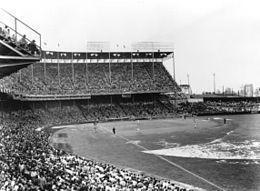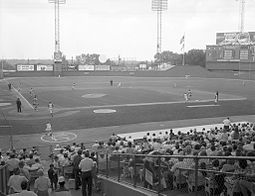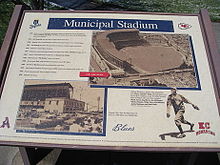- Municipal Stadium (Kansas City)
-
Kansas City Municipal Stadium Municipal Stadium 
First Athletics game at Municipal Stadium, 1955.Former names Muehlebach Field (1923-1937)
Ruppert Stadium (1937-1943)
Blues Stadium (1943-1954)Location 22nd Street and Brooklyn Avenue, Kansas City, Missouri Coordinates 39°5′9″N 94°33′25″W / 39.08583°N 94.55694°WCoordinates: 39°5′9″N 94°33′25″W / 39.08583°N 94.55694°W Broke ground 1923 Opened July 3, 1923 Demolished 1976 Owner City of Kansas City Operator City of Kansas City Surface Grass Construction cost US$400,000
($5.15 million in 2011 dollars[1])Architect Osborn Engineering Capacity 16,000 (1923)
35,561 (1972)Field dimensions 1923
Left Field - 350 ft
Center Field - 450 ft
Right Field - 350 ft1972
Left Field - 369 ft
Left Center - 408 ft
Center Field - 421 ft
Right Center - 382 ft
Right Field - 338 ftTenants Kansas City Blues (A.A.) (1923-1954)
Kansas City Monarchs (NNL and NAL) (1923-1931, 1937-1954)
Kansas City Blues / Cowboys (NFL) (1924-1926)
Kansas City Athletics (MLB) (1955-1967)
Kansas City Chiefs (AFL / NFL) (1963-1971)
Kansas City Spurs (NASL) (1968-1970)
Kansas City Royals (MLB) (1969-1972)Kansas City Municipal Stadium was a baseball and football stadium that formerly stood in Kansas City, Missouri. It hosted the minor league Kansas City Blues of the American Association from 1923 to 1954 and the Kansas City Monarchs of the Negro Leagues during the same period. The stadium was razed and rebuilt prior to the 1955 baseball season and hosted the Kansas City Athletics of the AL from 1955 to 1967, the Kansas City Royals of the AL from 1969 to 1972, and the Kansas City Chiefs of the AFL and NFL from 1963 to 1971, as well as other short-lived professional teams.
Contents
Early history
Municipal Stadium was originally built as Muehlebach Field in 1923 for the minor-league Blues for $400,000. It was named for Blues owner George E. Muehlebach, who also owned Muehlebach Beer and the Muehlebach Hotel.
It was located in the inner city neighborhood near 18th and Vine to house the minor league white Kansas City Blues baseball team and the Negro League Kansas City Monarchs.[2][3] The first Negro League World Series game was held at the stadium in 1924. Today, the Negro Leagues Baseball Museum is a few blocks from the site.
The stadium consisted of a single-decked, mostly covered, grandstand extending from the right field foul pole down around most of the left field line. When the New York Yankees bought the Blues for their farm system in 1937, the stadium was renamed Ruppert Stadium in honor of the Yankees owner, Col. Jacob Ruppert. Ruppert died two years later, and the stadium was renamed Blues Stadium in 1943.
Rebuilding
When Arnold Johnson bought the Philadelphia Athletics from Connie Mack in November 1954, he announced that he would move the team to Kansas City. He had purchased Blues Stadium a year earlier, but sold it back to the city. Muehlebach built Blues Stadium in 1923 with footings sufficiently strong to support a second-deck. However, when renovation work on Blues Stadium began to add a second-deck, it was discovered that the footings were not strong enough. City officials elected to raze Blues Stadium and rebuild from scratch. The city ran three-shifts and the new stadium was built in 90-days, completed in time for the April 1955 opening. The new construction was financed by a bond issuance.[4] The Braves Field scoreboard was purchased and moved to Kansas City and temporary bleachers were added in the left field corner and parts of the outfield.
Kansas City Athletics
Municipal Stadium was home to many of the shenanigans of Charlie Finley, who bought the A's after Johnson's death in 1960. Most notably, he tried to shorten the rather distant fences by creating a 296-foot (90 m) Pennant Porch in right-field, fronting a tiny bleacher section, to mock the famed short fence in right field at Yankee Stadium, home of the powerful Yankees. The move was quickly vetoed by the league. So Finley rebuilt the fence to the bare legal minimum of 325 feet (99 m), and repainted the fence to say One-Half Pennant Porch. Later he tried the ruse of putting a canopy over the little bleacher, which just happened to have an extension that reached out 29 feet over the field. The league, not amused by Finley's sense of humor, again ordered him to cease and desist. According to legend, on a road trip that the A's made to New York, a Yankee hitter lofted a long fly ball to left field which, in the cavernous left field of Yankee Stadium, became a routine out. Yankees public address announcer Bob Sheppard is alleged to have then said over the microphone, "In Kansas City, that would have been a home run", itself a response to Finley's dictum for Municipal Stadium public address announcer Jack Layton to announce, "That would have been a home run at Yankee Stadium" for any ball hit beyond a line Finley painted in the outfield grass 296 feet away from home plate in Kansas City.
In addition to his notorious tinkering with the right field corner, Finley experimented with moving the other fences in and out several times during his seven seasons operating the team here. None of those moves had any notable effect on the team's performance, as the club finished in or near last place nearly every year.
A small zoo with goats and sheep and picnic area stood behind the right-field fence. When home runs were hit into the field the goats and sheep would scamper up the hill. At the same time, Finley replaced the Athletics' old elephant mascot with a live mule, appropriately named "Charlie-O".
At home plate a mechanical rabbit, nicknamed "Harvey" in reference to the stage play and film Harvey, rose out of the ground with new baseballs for the umpire and a compressed-air device (nicknamed "Little Blowhard") blew dirt off of home plate.
During the years when two major league All-Star Games were scheduled each year instead of one, Municipal Stadium hosted the first of the two 1960 games, with the NL winning the contest 5-3.
On September 17, 1964, The Beatles played Municipal Stadium as part of their first U.S. tour. The date was originally supposed to be an off-day for the band, but they agreed to perform when Finley offered their manager, Brian Epstein, a then-record sum of $150,000. The group opened the concert by saluting the host town with their medley of "Kansas City" and "Hey, Hey, Hey, Hey".
Kansas City Chiefs
When the Dallas Texans of the AFL moved to Kansas City in 1962, becoming the Kansas City Chiefs, Municipal Stadium was readied for football. Temporary stands were erected in left field to expand the stadium's capacity each fall, but had to be removed during the baseball season. The double-decked grandstand extended all the way across the south sideline (first base line of the baseball field), but ended halfway around the west end zone (third base on the baseball diamond). Both teams' benches were on the north sideline in front of the temporary bleachers, as was the case at other baseball stadiums converted to football use such as Milwaukee County Stadium, Metropolitan Stadium, Tiger Stadium and Wrigley Field. The east end zone ended at the right field fence, and the large scoreboard was in this end of the stadium. Due to the fence, there was significantly less room between the end line and the fence of the east end zone than there was in the west end zone, where there was a significant amount of room between the end line and the grandstand.[5]
The Chiefs' final game at Municipal Stadium was played on Christmas Day 1971. The double-overtime playoff contest (a loss to the Miami Dolphins) remains the longest game in NFL history.[6] This classic was the only post-season football game ever played at Municipal Stadium.
Kansas City Royals
As Municipal Stadium aged, it became clear that new facilities would be needed, and public bonds were issued in 1967 to fund a complex including separate football and baseball stadiums. It came too late for the A's, however, as they moved to Oakland after the 1967 season. Instead, Kansas City was awarded a new American League team for 1969, and the Royals used Municipal Stadium as a temporary home.
After the 1972 baseball season, Municipal Stadium was replaced by Royals Stadium for the Kansas City Royals and the adjacent Arrowhead Stadium for the Kansas City Chiefs. Municipal Stadium was demolished in 1976, and replaced by a municipal garden. Currently, the former ballpark site is being redeveloped with new single family homes.
References
- ^ Consumer Price Index (estimate) 1800–2008. Federal Reserve Bank of Minneapolis. Retrieved December 7, 2010.
- ^ K.C. Municipal Stadium - Ballparks of Basebball - Retrieved March 31, 2009
- ^ Kansas City Municipal Stadium - Ballparktour.com - Retrieved March 31, 2009
- ^ "A's Municipal Stadium Constructed in 90 Days". The Victoria Advocate: p. 8. 1958-03-01. http://news.google.com/newspapers?id=S69TAAAAIBAJ&sjid=-YcDAAAAIBAJ&pg=3070,47856&dq=kansas+city+municipal+stadium&hl=en.
- ^ Stadiums of the NFL - Retrieved December 8, 2010
- ^ The longest NFL game ever played: 'Twas the night of Christmas - tcpalm.com - December 17, 2008
External links
- Municipal Stadium Facts, figures, photos and more
- Information at BallparksofBaseball
- Stadium history at BallparkTour
- Municipal Stadium site today
Events and tenants Preceded by
Association ParkHome of the Kansas City Blues
1923 - 1954Succeeded by
last ballparkPreceded by
Association ParkHome of the Kansas City Monarchs
1923 - 1954Succeeded by
last ballparkPreceded by
Shibe ParkHome of the Kansas City Athletics
1955 - 1967Succeeded by
Oakland-Alameda County ColiseumPreceded by
Los Angeles Memorial ColiseumHost of the All-Star Game
1960 1st GameSucceeded by
Yankee StadiumPreceded by
Cotton BowlHome of the Kansas City Chiefs
1963 - 1971Succeeded by
Arrowhead StadiumPreceded by
first ballparkHome of the Kansas City Royals
1969 - 1972Succeeded by
Royals StadiumKansas City Royals Based in Kansas City, MissouriThe franchise History • Expansion Draft • Seasons • Current Roster • Owners and executives • Managers • Opening Day starting pitchers • All-Time Roster • First-round draft picks • Team Records • No-hitters • Awards & League Leaders • Broadcasters • Fox Sports Kansas City • Royals Sports Television NetworkBallparks Municipal Stadium • Kauffman Stadium
Spring Training: Terry Park • Baseball City Stadium • Surprise StadiumCulture Rivalries St. Louis CardinalsTeam Hall of Fame Steve Busby • Amos Otis • Dick Howser • Cookie Rojas • Paul Splittorff • Dennis Leonard • Hal McRae • Joe Burke • Larry Gura • Freddie Patek • Ewing Kauffman • George Brett • Frank White • Muriel Kauffman • John Mayberry • Dan Quisenberry • Whitey Herzog • Willie Wilson • Jeff Montgomery • Denny Matthews • Bret Saberhagen • Mark Gubicza • Art StewartRetired numbers Minors Key personnel World Series
championships (1)American League
pennants (2)Division titles Seasons (43) 1960s 1970s 1980s 1990s 2000s 2010s 2010 • 2011 • 2012Kansas City Chiefs Formerly the Dallas Texans • Founded in 1960 • Based in Kansas City, MissouriThe Franchise Franchise • History • Players • First round picks • Coaches • Seasons • Logos and Uniforms • Awards • Quarterbacks (List) • OpponentsStadiums Cotton Bowl • Municipal Stadium • Arrowhead StadiumPersonnel Owner: Clark Hunt • General Manager: Scott Pioli • President: Denny Thum • Head Coach: Todd Haley • Offensive Coordinator: Bill Muir • Defensive Coordinator: Romeo Crennel • Special Teams Coach: Steve HoffmanCulture Rivalries Owners (2) Presidents (5) General Managers (5) Head Coaches (11) Offensive Coordinators (14) Defensive Coordinators (15) Costello • Bettis • Rust • Carson • Daniel • Young • Rust • Cowher • Adolph • Cunningham • Schottenheimer • Robinson • Cunningham • Pendergast • CrennelSpecial Teams Coach (13) Playoff Appearances (16) Division Championships (8) Super Bowl Appearances (2) League Championships (4) Retired numbers (8) Pro Football Hall of Fame members (14) First Round Picks (51) Haynes • Holub • Bull • Buchanan • Budde • Beathard • Sayers • Brown • Trosch • Moorman • Daney • Marsalis • Smith • Wright • Kinney • Green • Walters • Green • Still • Bell • Fuller • Budde • Scott • Hancock • Blackledge • Maas • Alt • Horton • Jozwiak • Palmer • Smith • Thomas • Snow • Williams • Carter • Hill • Jenkins • Woods • Gonzalez • Riley • Tait • Morris • Sims • Johnson • Johnson • Hali • Bowe • Dorsey • Albert • Jackson • Berry • BaldwinSeasons (51) 1960 • 1961 • 1962 • 1963 • 1964 • 1965 • 1966 • 1967 • 1968 • 1969 • 1970 • 1971 • 1972 • 1973 • 1974 • 1975 • 1976 • 1977 • 1978 • 1979 • 1980 • 1981 • 1982 • 1983 • 1984 • 1985 • 1986 • 1987 • 1988 • 1989 • 1990 • 1991 • 1992 • 1993 • 1994 • 1995 • 1996 • 1997 • 1998 • 1999 • 2000 • 2001 • 2002 • 2003 • 2004 • 2005 • 2006 • 2007 • 2008 • 2009 • 2010 • 2011The Kansas City Area Kansas City • The Metro Area • History • Economy • Neighborhoods • Architecture • Fountains • Barbecue • Jazz • Broadcast • Film • Education • SportsCategories:- 1923 establishments in the United States
- 1972 disestablishments
- Defunct Major League Baseball venues
- Defunct National Football League venues
- Demolished sports venues in the United States
- Negro league baseball venues
- American Football League venues
- Kansas City Monarchs
- Kansas City Athletics stadiums
- Kansas City Chiefs stadiums
- Kansas City Royals stadiums
- Sports venues in Kansas City, Missouri
- Baseball venues in Missouri
Wikimedia Foundation. 2010.



